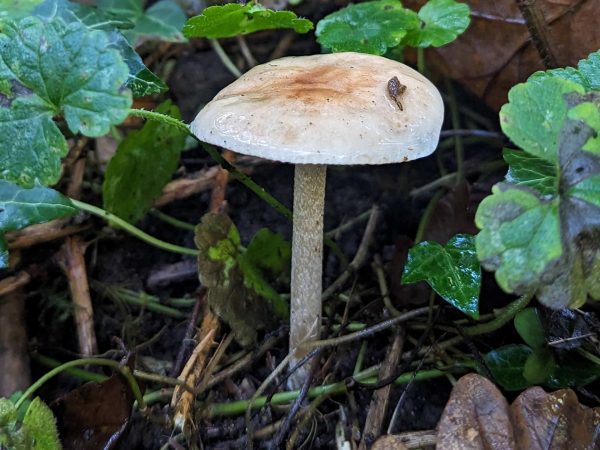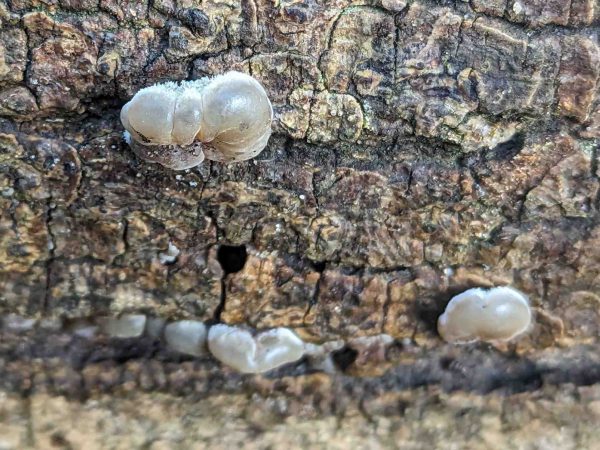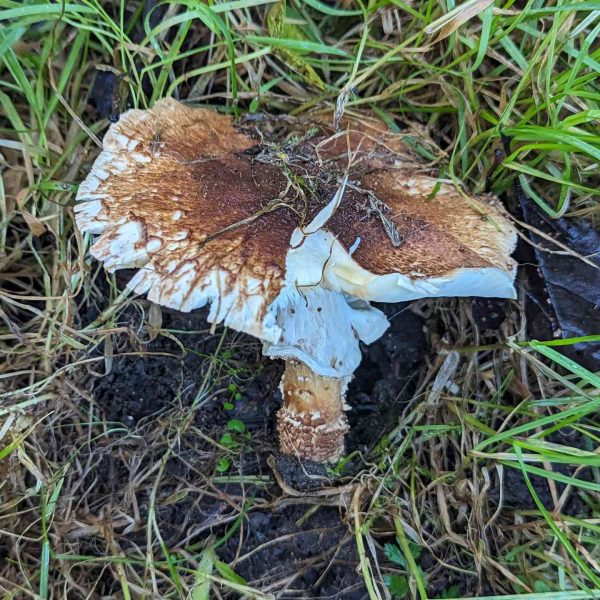Day 11
– 14 October 2023
Click on an image to see the fungus entry page
Today was damp and throughout the reserve woodland some trees had fallen from the previous night’s strong wind and rain.
Despite this, it was warm in the sun.
Entrance Area
The Agaricus in the entrance yard and the Datronia left of the entrance path were still around.
Further along the path, in the same area as in Day 1, I spotted another of what looked like Amanita phalloides (Fig. 11.0).
BASECAMP AREA
In the Zen Zone, I found a small group of Calocera cornea on a large log.
The slime moulds on the log leading down to Basecamp had disappeared, but the Tubifera ferruginosa clumps on the Basecamp Loop log were still there.
I spotted a few Hebeloma mesophaeum (Fig. 11.1) fungi in the leaf litter and grass.
In Basecamp, the Dacrymyces stillatus from last week had grown larger and more moist, and the Stemonitis axifera had turned lighter.
There were remains of Candolleomyces candolleanus, and the Scutellinia scutellata were still there.
All over the logs, there were emerging and fully grown brackets (Fig. 11.2), and many small jellies — one yellowish orange and another tiny and white (Fig. 11.3).
The Ramaria stricta was still there, but another group had sprung up beside it.
On the Basecamp railway path, I found a large, red-scaled fungus (Fig. 11.4) and Coprinopsis lagopus in the grass.
The Stereum hirsutum on the oak tree had become more colourful with the rain.
Just off the path, I spotted a large, clustered group of glossy fungi — possibly Hypholoma fasciculare — growing off a stump (Fig. 11.5).
THE DELL
In the Dell, Xylaria hypoxylon had started to appear on all the wood, and nearby I found Xylaria longipes (Fig. 11.6).
I saw many tiny Mycena acicula fruitbodies (Fig. 11.7).
The Artomyces pyxidatus had broken apart, but on the same log I found a slimy greyish fungus (Fig. 11.8) and a slimy buff fungus (Fig. 11.9).
Around the branch circle, I found some buff jelly fungi (Fig. 11.10), then saw the Laccaria amethystina from previous days.
I also saw some Xerocomellus chrysenteron ( it didn’t seem to bruise blue at the base, so I assume it wasn’t X. cisalpinus ), and the Calocera cornea from days before.
SANDY GLADE AREA
In the Sandy Glade Area, the Arcyria denudata had mostly diminished into spore masses, but there were still a few sporangia on the wood.
There were a few Leucocoprinus brebissonii and the Trametes versicolour was still there, but the Hemitrichia clavata had all but gone.
ENCLOSED AREA
In the Enclosed Area, the Collybiopsis ramealis had disappeared, but the Tricholoma fulvum and Clavulinopsis luteoalba had remained the same.
YEW GROVE AREA
In the area opposite the Yew Grove, there were fewer Cyathus striatus, but still some Clavulina cinerea.
At the Yew Grove itself I found a large Coprinopsis atramentaria (Fig. 11.11) growing out beside one of the logs.
OUTPOST AREA
On the way to The Outpost, the Chlorociboria and Inocybe geophylla were still there.
I spotted some purple brackets — Phlebiopsis crassa (Fig. 11.12) — and the Calocera cornea from previous weeks.
There were a few different Russula species (Fig. 11.13), Lactarius tabidus (Fig. 11.14), Laccaria bicolour and much more Hypholoma fasciculare.
Just after The Outpost, I came across a juvenile, pale fungus just coming out the earth (Fig. 11.15); beside it I spotted a singular Mycena rosea (Fig. 11.16).
TRAIL END AREA
In the Trail End Area, there was an abundance of an unidentified copper-coloured, medium-sized fungus (Fig. 11.17).
The Apioperdon pyriforme from Day 10 were still around.
I also saw the Lycogala epidendrum from last week.
OTHER
As before, Scleroderma citrinum were everywhere.
I also saw lots of Hypholoma fasciculare and many little brown mushrooms — specifically Mycena galericulata and M. galopus.
The Hydnum repandum had mostly disintegrated.

















